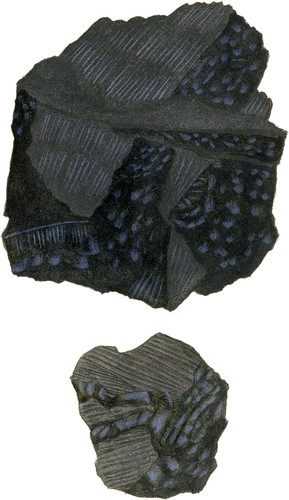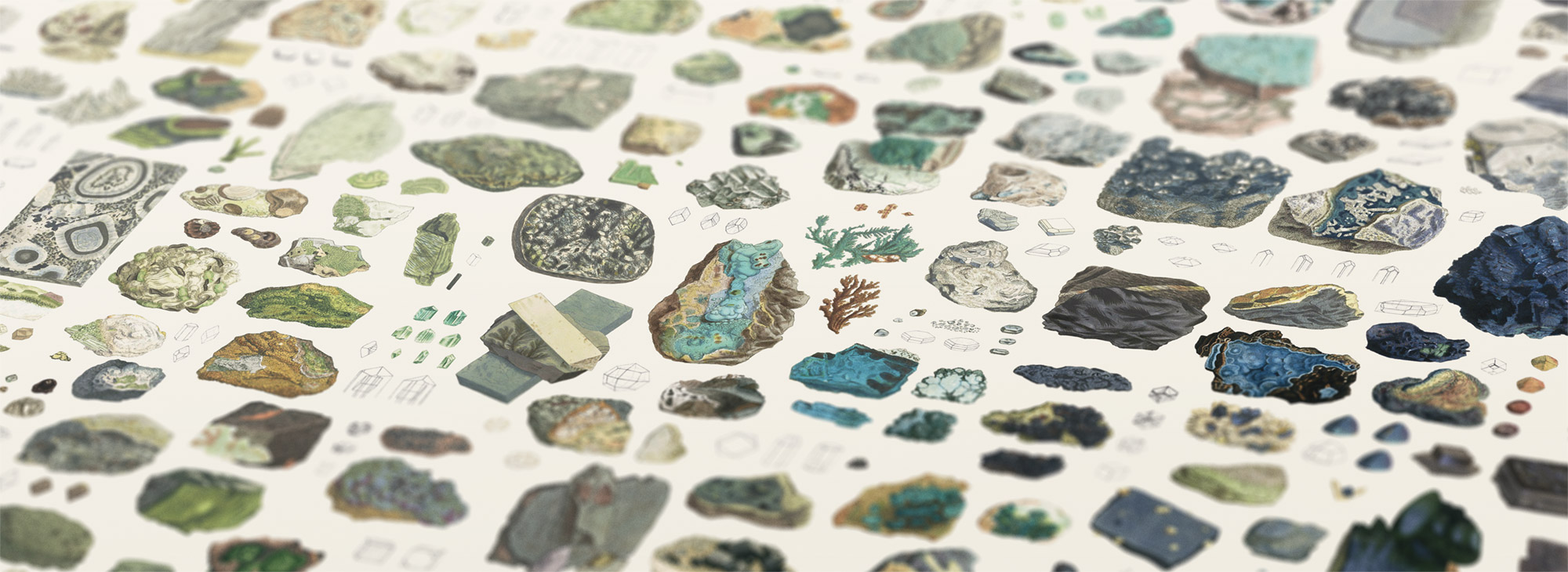 Enlarge
Enlarge
British Mineralogy
Oxygenized Carbon
- Class 1. Combustibles.
- Ord. 1. Homogeneous.
- Gen. 6. Carbon.
- Spec. 2. Oxygenized Carbon.
- Gen. Char. Hardest of all known substances.
- Spec. Char. Carbon conbined with such a proportion of oxygen as to remain in a solid state, mostly opaque black.
- Syn. Native Mineral Carbon. Kirw. 2. 49*.
Some of the Swansea coals resemble the Denbigh coals in their structure, and are nearly the same in quality.
This upper figure has the charcoaly and stratified part in various directions. Some parts resemble burnt straw in regular rows: others form conical appearances, converging or diverging from a centre. We also find horizontal and oblique strata. The shining part is in various directions, with a confused and shattered appearance. Some of the striated parts were slightly covered with charcoal in fine dust, easily rubbed off, the striated impression still remaining in immediate contact with the shining part. In other parts were thick layers of charcoal in irregular strata, but somewhat horizontal to the other parts, the whole having a peculiar, yet confused, appearance. It is very brittle, and easily shattered to pieces.
The lower piece is much tougher, and the straiæ have not a vestige of coal about them, nor will they soil the fingers. This seems altogether more indurated. These two and the Denbigh coal have nearly the same qualities as to their uses. They are difficult to ignite, and burn without flame, remaining a long while, and giving a great heat, without much apparent change; whence they have been denominated Stone Coal. They are used for malting, and for burning lime, and are frequently mixed with such coals as will more readily inflame, to assist the burning. They are supposed to contain less oxygen with the carbon than other coals, and therefore require the assistance of those which contain more oxygen. It may not be amis to observe here that diamons require oxygen to assist their burning, in the proportion of 4 to 5 in a stron gheat; and in burning they pass into the black state of charcoal, continuing to burn like it, and giving out carbonic acid gas (see description, Tab. 1.†) in the same way, the carbon being aërated by the caloric or matter of heat. Although diamond has always been of high value, and well-known from the earliest ages, yet it was left for Mr. Tennant in the year 1796 to prove it to be a pure carbon. See Phil. Trans. 1797. p. 123.
Therea re other sorts of coal about Swansea, of which we shall speak hereafter. Coals mostly appear to be the combustible remains of vegetation, provided apparently to secure whole forests for the use after generations. They are mostly formed in the strata of plains, composed of marle, sandstones, and limestones, most of which show the remains of animal and vegetable petrifactions, or impressions. See Sandstones, Tab. XL. The blackened parts in those figures are apparently the remains of bituminous carbon, as it were in the last stage of infiltration.
- * When Mr. Kirwan wrote this, common charcoal was thought to be pure carbon; it is since found to be an oxide of carbon, and that Diamond is the only native mineral carbon known. Mr Kirwan’s description agrees with oxide of carbon, for which we quote him.
- † It is found native in some caverns, wells, and mines, and is called choke damp of the miners. It is often fatal to them.

